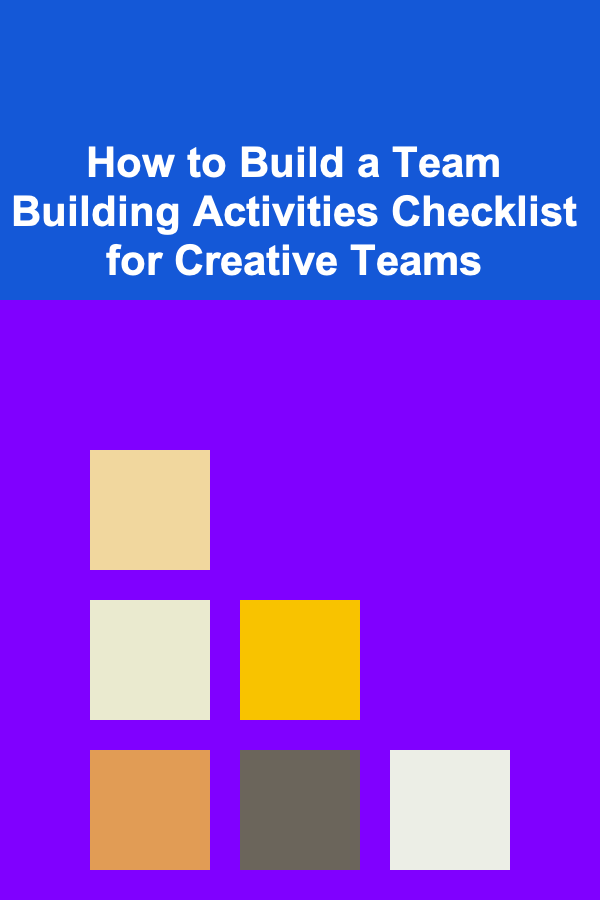
How to Build a Team Building Activities Checklist for Creative Teams
ebook include PDF & Audio bundle (Micro Guide)
$12.99$8.99
Limited Time Offer! Order within the next:

Building a strong, cohesive, and collaborative creative team requires more than just hiring talented individuals. It takes intentional effort to foster an environment where creativity can flourish, ideas are shared freely, and team members feel empowered to take risks. One of the most effective ways to encourage collaboration and creativity is through team-building activities that help break down barriers, build trust, and promote communication.
Creating a team-building activities checklist specifically for creative teams ensures that the activities are tailored to meet the unique needs of those in creative industries, such as design, advertising, content creation, and product development. In this article, we will explore how to build a team-building checklist that aligns with the goals of fostering creativity, collaboration, and innovation within your team.
Understand the Dynamics of Creative Teams
Before diving into the specifics of a team-building checklist, it's essential to understand the unique dynamics that creative teams bring to the table. These teams are often made up of individuals who are highly specialized in different areas, such as graphic design, copywriting, or web development. Each member has their own creative process and way of working. As such, the goal of team-building activities should be to:
- Encourage cross-functional collaboration: Creative teams often work in silos. Team-building activities should encourage interaction between people with different skill sets.
- Foster open communication: Creative teams thrive when members feel comfortable sharing ideas and providing feedback. The activities should promote transparency and constructive criticism.
- Build trust: Trust is essential in any team, especially for creative teams, where vulnerability and the sharing of new ideas are crucial.
- Spark creativity and innovation: Team-building activities should stimulate the creative process, pushing individuals outside of their comfort zones and encouraging innovative thinking.
Identify the Goals of Your Team-Building Activities
Every team is different, so it's crucial to clarify the goals you want to achieve with your team-building activities. Consider the following objectives when designing your checklist:
Team Cohesion
The primary goal of any team-building activity is to build stronger relationships among team members. The more cohesive your team is, the easier it becomes to collaborate effectively on creative projects.
Communication Improvement
For creative teams, good communication is critical. Team-building activities should focus on improving both verbal and non-verbal communication skills. They should also help team members understand how to communicate better during brainstorming sessions, presentations, and feedback rounds.
Problem-Solving Skills
Creative teams are often faced with challenging problems that require innovative solutions. Team-building activities that encourage problem-solving and critical thinking can help team members develop skills they can apply to their work.
Trust and Emotional Safety
Creativity thrives in an environment where team members trust one another and feel emotionally safe. Activities that encourage vulnerability, empathy, and mutual respect can foster a culture of trust within the team.
Fun and Enjoyment
While the focus should be on enhancing creativity and collaboration, it's also important to incorporate fun into team-building activities. A sense of enjoyment can reduce stress, improve morale, and strengthen team bonds.
Select the Right Team-Building Activities
The activities you choose should be engaging, relevant to your team's goals, and appropriate for the specific dynamics of your group. Below is a variety of team-building activities categorized to help you achieve different goals:
3.1 Creative Icebreakers
Icebreaker activities help team members get to know one another better and ease into collaboration. These activities are essential at the beginning of any team-building session or when you have new team members.
Examples:
- Two Truths and a Lie: Each team member shares two truths and one lie about themselves, and the rest of the group guesses which one is false. This activity promotes interaction and is a lighthearted way to start conversations.
- Creative Introductions: Ask each person to introduce themselves in an unconventional way, such as by using three words that describe their creative style or by showing an object that represents their personality.
- Pictionary or Doodle Challenge: A quick, fun way to warm up creativity by having team members draw and guess simple images. This activity promotes creativity in a relaxed, playful environment.
3.2 Collaborative Design Challenges
These activities encourage team members to work together to solve problems or come up with creative solutions. They can also help improve communication and trust within the team.
Examples:
- Group Brainstorming Session: Use a prompt or challenge related to your team's work and have everyone brainstorm ideas together. This exercise encourages open communication, shared ideation, and creative problem-solving.
- Build the Tallest Tower: In this activity, divide the team into small groups and give them materials (e.g., paper, tape, and scissors) to build the tallest tower in a limited amount of time. The goal is to collaborate effectively and think outside the box under time constraints.
- Logo Design Challenge: Split the team into pairs and ask them to create a logo for a fictional brand using a set of predefined criteria. This promotes creativity, collaboration, and healthy competition.
3.3 Outdoor and Active Challenges
Creative teams often spend long hours indoors working on screens. Outdoor or physically active team-building activities can help rejuvenate the mind, improve focus, and promote team bonding.
Examples:
- Scavenger Hunt: Organize a creative scavenger hunt where teams must find or create specific items within a given time frame. It encourages problem-solving, collaboration, and a break from routine.
- Escape Room Challenge: These games are fantastic for creative teams. They require team members to work together to solve puzzles, think critically, and communicate effectively under pressure.
- Outdoor Sketching or Photography Walk: Give team members a brief to sketch or photograph something they find in nature, encouraging creativity while offering a relaxing outdoor experience.
3.4 Reflection and Feedback Activities
Reflective activities encourage personal growth and team development. These activities also help build emotional intelligence, which is vital for a creative team working together over time.
Examples:
- Group Retrospective: After a project or activity, gather the team to reflect on what went well, what could have been improved, and how to apply the lessons learned in the future.
- Feedback Circles: Set up a session where each team member shares positive feedback about the work or contributions of another team member. It fosters a culture of appreciation and trust.
- Creative Journaling: Encourage team members to keep a journal during team-building sessions, writing about their thoughts, challenges, and breakthroughs. Sharing insights from personal journals can spark new perspectives and discussions.
3.5 Skill-Building Workshops
While fun is important, don't forget that team-building activities can also serve as opportunities for professional development. These workshops can help your team build practical skills relevant to their work, such as creative thinking, innovation, and leadership.
Examples:
- Creative Problem-Solving Workshops: Facilitate a session where team members learn how to approach creative problems from different perspectives, such as using design thinking or lateral thinking techniques.
- Improv Workshops: Improv classes can help creative professionals develop the flexibility and spontaneity needed for brainstorming and creative collaboration. They also improve communication skills and promote team bonding.
- Storytelling Masterclass: Since many creative professionals work in media, marketing, or content creation, workshops on storytelling techniques can help strengthen their communication abilities and enhance their creative output.
Build a Flexible and Inclusive Environment
While it's important to tailor team-building activities to specific goals, it's equally crucial to create an environment where everyone feels comfortable participating. This is especially important for creative teams, as individuals may feel vulnerable sharing their ideas and work. Consider the following:
- Encourage inclusivity: Ensure that the activities are accessible to everyone, including those who may have different physical abilities, learning styles, or personalities.
- Be mindful of introverts and extroverts: Balance group activities with opportunities for quieter, individual reflection. This ensures that everyone, regardless of personality type, feels valued.
- Make activities optional: Not every team member will enjoy the same activities. Offering a variety of options allows individuals to choose the ones that resonate with them most.
Evaluate and Adjust Regularly
After implementing your team-building activities, it's essential to evaluate their effectiveness and adjust your approach as needed. Gather feedback from your team, track improvements in communication and collaboration, and make changes to future activities based on the needs and preferences of your team members.
Conclusion
Team-building activities are an integral part of developing a creative team that thrives on collaboration, trust, and innovation. By carefully selecting and tailoring activities to your team's unique needs, you can create a more cohesive, productive, and inspired creative environment. Keep in mind that team-building is an ongoing process, and by consistently incorporating thoughtful, fun, and meaningful activities, you'll continue to foster creativity and strengthen your team's bond.
Reading More From Our Other Websites
- [Home Holiday Decoration 101] How to Choose the Perfect Holiday Decor for a Party That Wows Everyone
- [Home Renovating 101] How to Create a Timeless Bathroom Renovation
- [Home Storage Solution 101] How to Maximize Small Spaces with Creative Storage Solutions
- [Personal Care Tips 101] How to Make Sunscreen Part of Your Daily Skincare Routine
- [Organization Tip 101] How to Create an Efficient Laundry Room Organization System
- [Survival Kit 101] How to Store Emergency Food and Water for Your Survival Kit Without Compromise
- [Scrapbooking Tip 101] Secret Tools & Tricks Professionals Use to Speed Up Their Scrapbooking Workflow
- [Home Storage Solution 101] How to Make the Most of Hidden Storage in Your Furniture
- [Home Staging 101] How to Incorporate Seasonal Decor in Home Staging
- [Home Security 101] How to Train Your Family to Be More Aware of Home Security

Exploring Passive Income from Deep Learning-Powered Automation
Read More
How to Prepare a Weekly Meal Plan Using Organized Recipes
Read More
How to Set Up a Home Maintenance Checklist
Read More
Why Regular Maintenance Keeps Your Home Organized
Read More
Caring for Your Bike: A Deep Dive into Cleaning Solvents and Lubricants
Read More
How to Play Liar's Dice: A Beginner's Guide
Read MoreOther Products

Exploring Passive Income from Deep Learning-Powered Automation
Read More
How to Prepare a Weekly Meal Plan Using Organized Recipes
Read More
How to Set Up a Home Maintenance Checklist
Read More
Why Regular Maintenance Keeps Your Home Organized
Read More
Caring for Your Bike: A Deep Dive into Cleaning Solvents and Lubricants
Read More